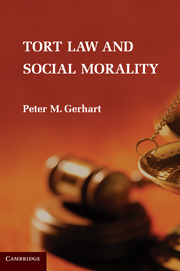Book contents
- Frontmatter
- Contents
- Preface
- Acknowledgments
- PART I OTHER-REGARDING BEHAVIOR
- PART II THE NORMATIVE JUSTIFICATION
- PART III THE THEORY APPLIED
- 6 Social Cohesion and Autonomy: The Justificational Boundary of Duty
- 7 Social Cohesion and Moral Agency: The Justification for Proximate Cause
- 8 Social Cohesion and Strict Liability
- 9 Using Another's Property
- 10 Product Liability: Social Cohesion and Agency Relationships
- 11 Customer-Centered Enterprise Liability
- 12 Social Cohesion and Knowledge: The Intentional Torts
- PART IV SUMMARY AND IMPLICATIONS
- Index
9 - Using Another's Property
Published online by Cambridge University Press: 04 August 2010
- Frontmatter
- Contents
- Preface
- Acknowledgments
- PART I OTHER-REGARDING BEHAVIOR
- PART II THE NORMATIVE JUSTIFICATION
- PART III THE THEORY APPLIED
- 6 Social Cohesion and Autonomy: The Justificational Boundary of Duty
- 7 Social Cohesion and Moral Agency: The Justification for Proximate Cause
- 8 Social Cohesion and Strict Liability
- 9 Using Another's Property
- 10 Product Liability: Social Cohesion and Agency Relationships
- 11 Customer-Centered Enterprise Liability
- 12 Social Cohesion and Knowledge: The Intentional Torts
- PART IV SUMMARY AND IMPLICATIONS
- Index
Summary
A litmus test for any theory of tort law is the Vincent case, which I take up now. The central problem is to find a justification for the outcome in Vincent that does not either (1) undercut a general theory of tort law by constituting a special exception to a general theory of responsibility or (2) rely on a conclusory, nonspecified assignment of rights. Vincent also tests the strict liability concept because Vincent is uniformly understood to be about liability without fault. In this chapter, I present and defend a different view of Vincent. I claim that justificational analysis allows us to understand Vincent in a detailed and precise way that integrates it with the general responsibility of one person for the well-being of another. Under this view, Vincent emerges as a case in which the failure to repair the damage was faulty even though the conduct that caused the damage was not faulty. Once we understand fault as inappropriate regard for the well-being of others, we can explain why sometimes even reasonable conduct can be faulty.
THE JUSTIFICATIONAL PROBLEMS OF VINCENT
In Vincent, the defendant ship owner made the reasonable decision to lash his ship to a dock during a storm, knowingly inflicting harm to the dock in order to avoid the greater harm if the ship had left the dock.
- Type
- Chapter
- Information
- Tort Law and Social Morality , pp. 179 - 193Publisher: Cambridge University PressPrint publication year: 2010



